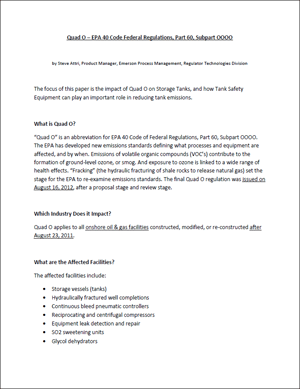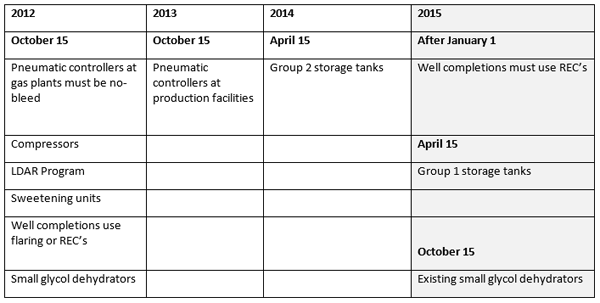If you’re an energy producer here in the United States, you likely already familiar with the Environmental Protection Agency’s “Quad O” regulations, or officially, EPA Title 40, C.F.R. Part 60, Subpart OOOO—Standards of Performance for Crude Oil and Natural Gas Production, Transmission and Distribution.
The EPA defines its purpose:
This subpart establishes emission standards and compliance schedules for the control of volatile organic compounds (VOC) and sulfur dioxide (SO2) emissions from affected facilities that commence construction, modification or reconstruction after August 23, 2011.
 Emerson’s Steve Attri has written a whitepaper, Quad O – EPA 40 Code Federal Regulations, Part 60, Subpart OOOO that explores the impact of Quad O on storage tanks, and how tank safety equipment can play an important role in reducing tank emissions.
Emerson’s Steve Attri has written a whitepaper, Quad O – EPA 40 Code Federal Regulations, Part 60, Subpart OOOO that explores the impact of Quad O on storage tanks, and how tank safety equipment can play an important role in reducing tank emissions.
These regulations quantify the emissions reductions required for many types of processes and units including:
- Storage vessels (tanks)
- Hydraulically fractured well completions
- Continuous bleed pneumatic controllers
- Reciprocating and centrifugal compressors
- Equipment leak detection and repair
- SO2 sweetening units
- Glycol dehydrators
Here are the compliance deadlines since the regulations were enacted in August of 2012:
I’ll highlight the storage tank deadlines and point you to the whitepaper for the other ones. For storage vessels:
Tanks that emit more than 6 tons of VOC’s (volatile organic compounds) per year are considered affected facilities. Per Quad O, emissions need to be reduced by 95%. Emission control devices such as closed vent systems, enclosed combustion devices, and vapor recovery units are outlined in the regulation.
Compliance dates have been staged by “Group 1” and “Group 2” tanks. Group 2 tanks are those that were commissioned after April 12, 2013. The deadline for compliance was April 15, 2014. Group 1 tanks are those commissioned between August 23, 2011 and April 12, 2013. The deadline for these is April 15, 2015.
Read the whitepaper to see descriptions for hydraulically-fractured well completions, continuous bleed pneumatic controllers, reciprocating and centrifugal compressors, equipment leak detection and repair, SO2 sweetening units and glycol dehydrators.
Steve notes that tight valves lead to less emissions in both the management of high pressure and protection against “upset pressure”:
The objective is to exhaust the minimum amount of vapor necessary to maintain proper tank pressure [through a pressure vacuum relief vent (PVRV)]. This will control emissions and will also conserve the product stored in the tank.
…
An emergency vent should also seal tightly closed when pressures are within a normal operating range. If it does not, then the potential for emissions is great due to its large circumference.
For vapor control, if a vapor control system is required to collect vapors emanating from the tank:
…flame and detonation arrestors also come into play to protect the system from a flame travelling back into a tank or series of tanks. A flame arrestor is positioned in the piping, in between the tank(s) and the vapor control system. The arrestor contains a large flame element that absorbs the heat from any flame that is moving toward the tank(s). This safety protection is very important, and when the system is functioning normally, the arrestor should not restrict vapor flow.
Steve concludes:
The 2015 Quad O compliance deadlines are eminent. Of these, the April 15, 2015 deadline pertaining to “Group 1” tanks may affect the most oil & gas facilities.
Tanks that emit more than 6 tons of VOC’s (volatile organic compounds) per year are considered affected facilities. Per Quad O, emissions need to be reduced by 95%. Emission control devices such as closed vent systems, enclosed combustion devices, and vapor recovery units are outlined in the regulation. In addition to these, Tank Safety Equipment can help in the reduction of VOC’s. Tighter sealing pressure valves and gauges translate to lower emissions. When vapor control systems are used, Tank Safety Equipment plays an important role in providing the delivery of vapors to the system, limiting the amount of vapor release, and in protecting it through the use of arrestors.
You can connect and interact with pressure regulation and control experts in the Regulators group of the Emerson Exchange 365 community.






